- Joined
- Jul 27, 2009
- Messages
- 2,208
Breeding attempt successful.
Preparation
Female is housed in a 12"x12"x18" enclosure, with a cork slab placed in the corner, creating a "tube" area for a hide. The bottom is slightly angled out to provide more room at the bottom.
The female has been (and will continue to be) subjected to seasonal changes that mirror native habitat (Hyderabad area) as close as possible. Using local weather as a guide, late Fall/Winter/early Spring was designated the rainy seasons (enclosure kept more humid, occasional mild "flooding" of substrate, cooler temperatures) while late Spring/Summer/early Fall became the dry seasons (drier enclosure/substrate, warmer temperatures). To achieve a "wet season", plastic was placed over the top vents of the enclosure, the water dish was kept full, and a rare slight flooding of the substrate was done. For the dry season, the plastic was removed, the substrate was allowed to become dry, and the dish was only filled occasionally. At no point during the breeding/incubation was temperature artificially changed, other than maintaining non-freezing, comfortable room temperature during winter time. The intent was simply to have distinct seasons; no special attention was paid to specific humidity or temperature values. Using this cycle, the female predictably molts in late July/early August, just past the middle of the dry season. Female was fed the night before mating attempts, though she did not eat the second time.
The male was acquired in late July; his maturing molt was 05/28/13. The male sustained serious injury to both back legs during transit, and was housed in a small 11"x5" round container with a piece of cork and water dish to recover (this became his enclosure for the duration of his stay with me).
Although he did recover enough to be able to function normally, he never fully regained a full range of motion in his back legs. He was allowed to create a sperm web before any pairings.
[YOUTUBE]EHliiqtbtso[/YOUTUBE]
[SUP]MM P. metallica injury[/SUP]
[youtube]_XPYtuOLMbs[/youtube]
[SUP]MM P. metallica tapping[/SUP]
Pairing
The male was simply placed into the females enclosure, at the foot of her hide. The male immediately began to rhythmically tap his palps, and the female could be heard responding with taps of her own.
The female emerged, and the male seemed adamant about luring her away from her hide, even trying to lure her outside of the enclosure. The females furrow visibly dilated during courtship. A few attempts were made by the male for an insertion that were not followed through for whatever reason, though both seemed eager to continue courtship (one attempt seen on the video below). After a few hours, a clear insertion was made by the male, that lasted less than a second. Immediately afterward, the female seemed to loose all interest in his company and very quickly retreated into her hide (by this time, they were on the opposite corner of the enclosure). The male did not pursue, but instead remained and continued to tap, but gradually stopped both in intensity and frequency. At this point, he was removed from the enclosure. A second successful pairing occurred about three weeks later that followed the same basic format at the first.
The male was never allowed to cohabitate with the female past an insertion. This female was paired only twice.
[YOUTUBE]HzQM3jq9gX0[/YOUTUBE]
[SUP]P. metallica pairing[/SUP]
Eggsac preparation and brooding
After the pairing, the female was continually kept as per the season, which at the time of pairing (early August) was just at the tail end of the dry season. She was gradually kept more humid beginning in mid October for the wet season until around April/May when things were dried out again. As things were getting warmer and drier, she barricaded herself in her hide with some excavated dirt from the bottom of her burrow. By mid May, as her enclosure remained almost bone dry, she made a sac in her excavated chamber at the bottom of her burrow.
At this point, in interest of keeping the sac from desiccating, her water dish was refilled and a small portion of her substrate moistened. The mother seemed to favor keeping the sac on the floor of chamber, and was rarely observed to be holding it up or anywhere off the floor. Disturbances were kept to a minimum, only the occasional check to see that she still, in fact, had the sac! She was not fed during the brooding period, as she remained inside her barricade for the entire duration.
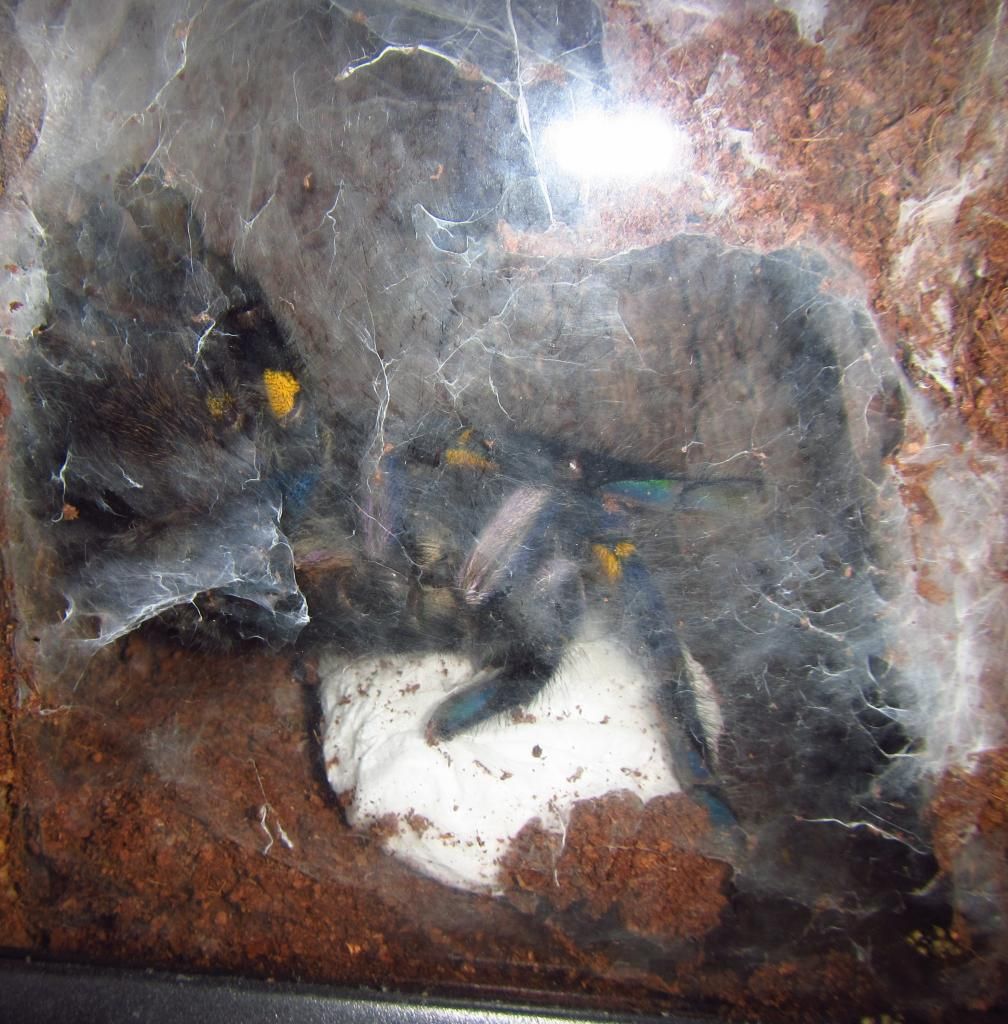
[SUP]Mother with sac[/SUP]
Pulling the eggsac
The sac was pulled after three weeks. The female did not put up any kind of resistance, and made no attempt to recover the sac as it was pulled from under her.
When opened, it was discovered that the sac was still wet on the inside, though no rotten or ruptured eggs were to be seen.
Eggs were carefully rolled onto coffee filters to dry them out before placing them in the incubator. There were ninety three eggs in total, many of them obviously infertile.
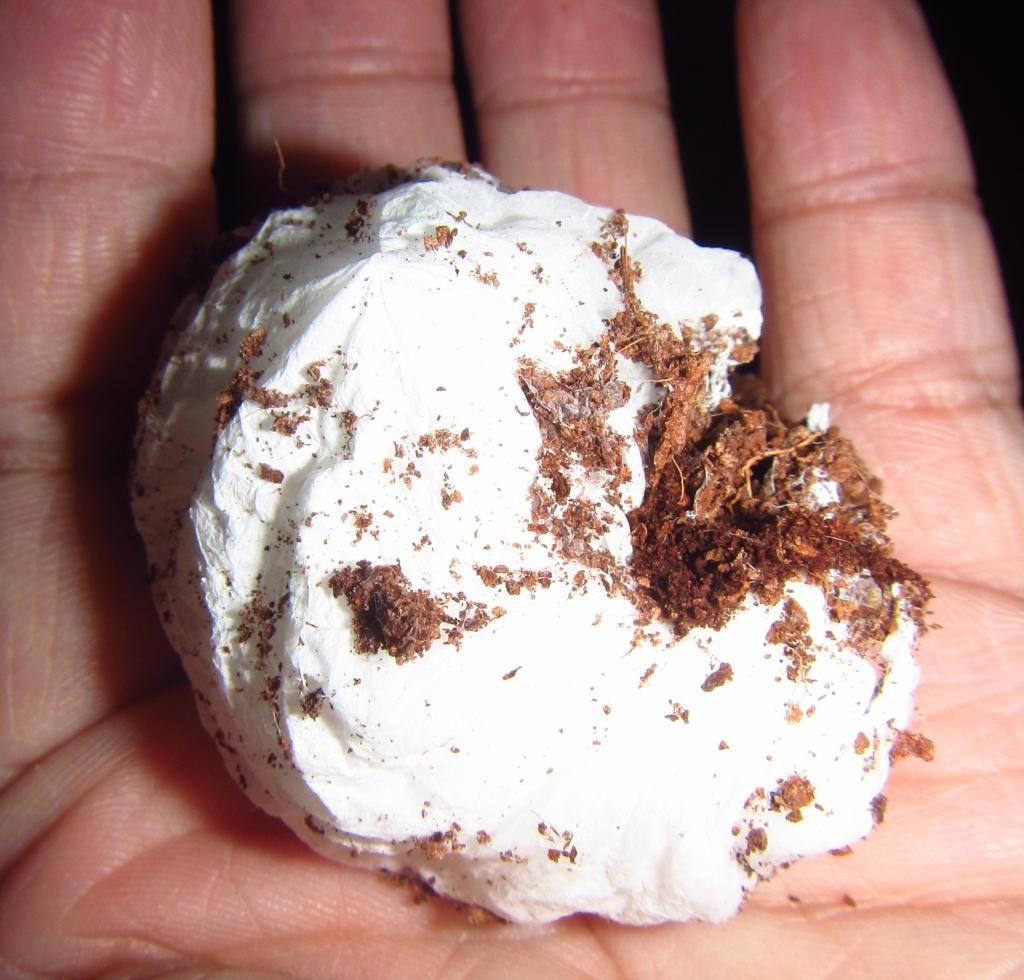
[SUP]P. metallica sac[/SUP]
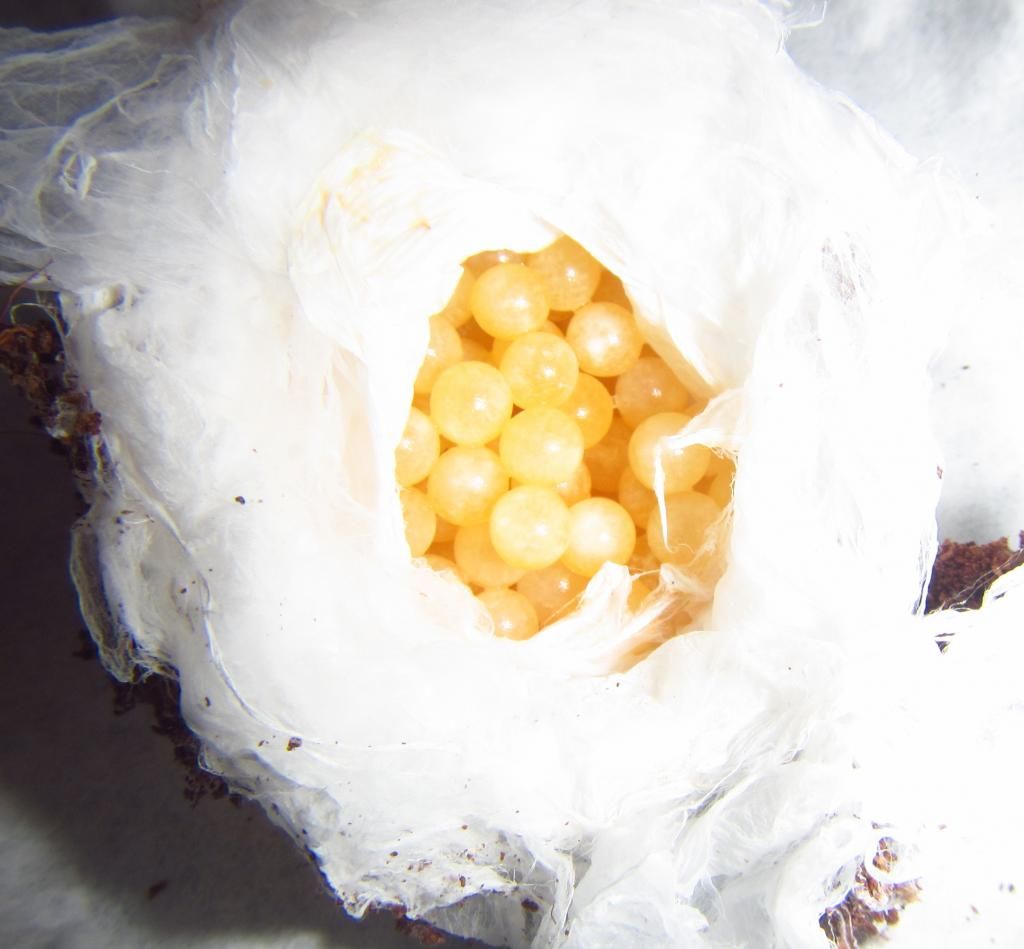
[SUP]P. metallica sac, opened[/SUP]
Incubation
Eggs/instars were incubated suspended on pantyhose over water using a delicup with the top cut off and pantyhose wrapped around the bottom. This was placed in a plastic container lined with sopping wet paper towels on the bottom. Four tiny ventilation holes were made on the top to keep humidity fairly high, and keep pests out.
Once they reached second instar, the delicup was placed in a container filled with moist coir, as the spiderlings had begun to crawl around.
Throughout incubation, the incubator was opened at least once every day to examine the slings and prevent stagnant air.
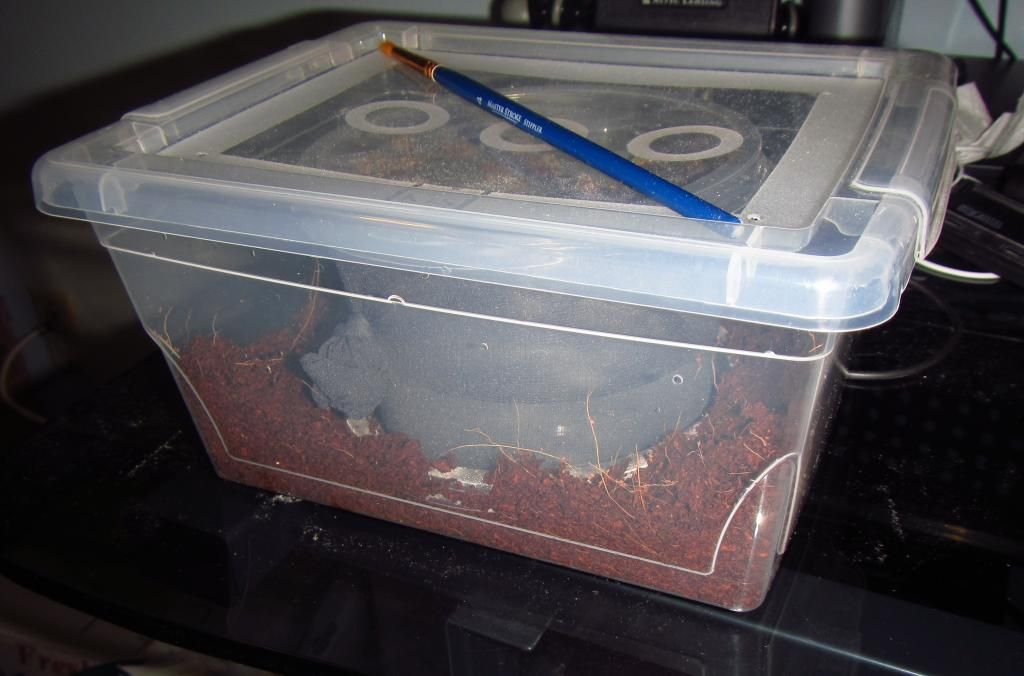
[SUP]Incubator, post first instar[/SUP]
Eggs to post embryos
Eggs showed development over the course of the week, with legs/carapace development being clearly observed inside the eggs.
Then, over the course of a few days, the eggs began hatching into post embryos about a week after the sac was pulled. Most of eggs successfully hatched on their own, but there were a few that failed to hatch despite obvious development underneath. These were manually hatched by very carefully applying gentle pressure between two wet fingers on the abdomen, in an attempt to "pop" the membrane without damaging the embryo underneath. Almost all of the eggs hatched this way had some kind of physical deformity, usually crooked legs.
At this point, all the unfertilized/dead eggs and were removed. Sixty three post embryos remained in total. The temperature during this part of the incubation hovered around the mid seventies.
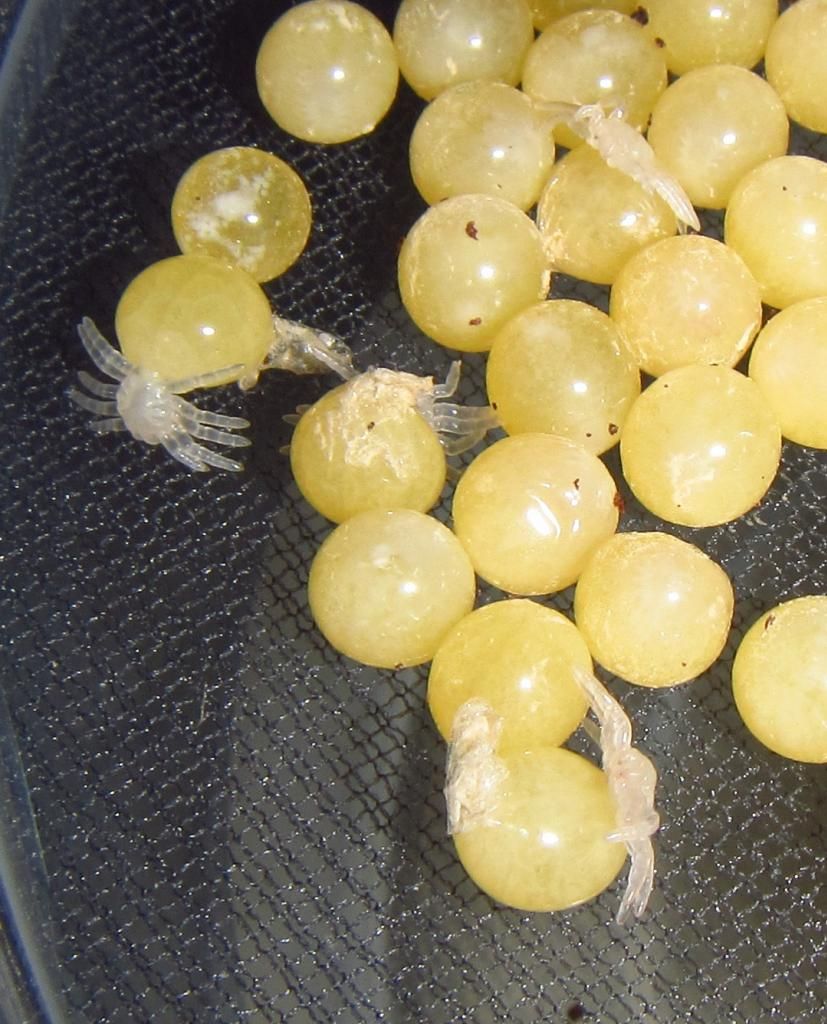
[SUP]Newly hatched post embryos[/SUP]

[SUP]All the manually hatched post embryos[/SUP]
Post embryos to first instar
Post embryos began to molt into first instars after about three weeks. During that time temperatures again hovered around the mid seventies. As they progressed towards the molt date, they grew visibly darker, especially on the legs, and seemed to move their limbs about more. Most of the post embryos that were manually hatched either did not molt, or were unable to complete the molt despite obvious darkening. One individual became stuck halfway due to crooked legs, but was able to complete the molt after being moistened with water and the molt being held to allow gravity to assist. In addition to the above, a few individuals displayed leg deformities (short legs, legs curved the opposite way, clubbed legs, etc.). It is assumed these were the individuals manually hatched.

[SUP]Post embryos molting into first instar[/SUP]
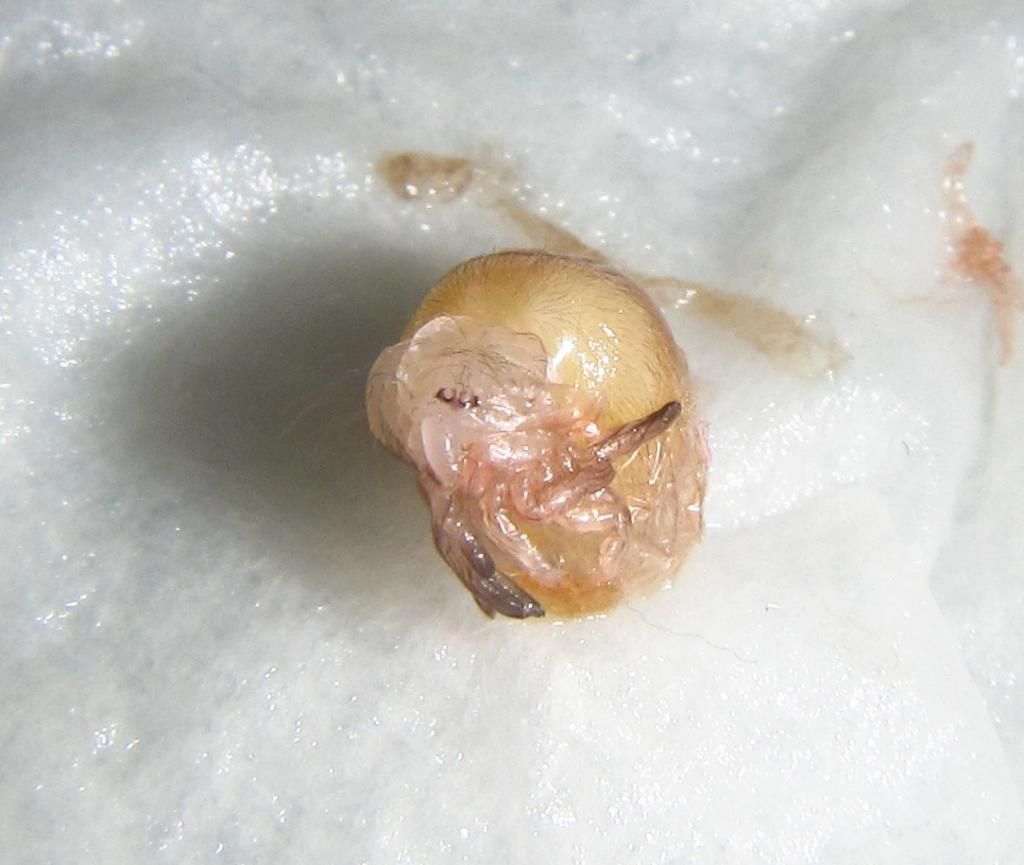
[SUP]Problematic molt[/SUP]
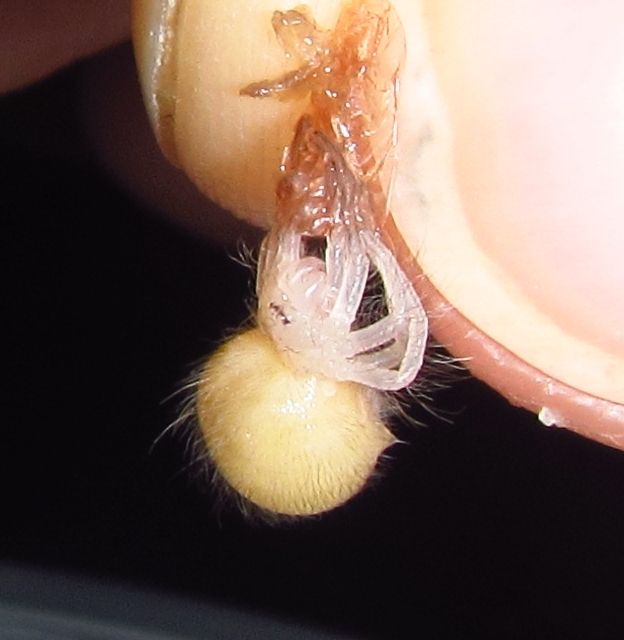
[SUP]Assisted molt[/SUP]

[SUP]Deformed first instar[/SUP]
[YOUTUBE]xwab1VKrNrs[/YOUTUBE]
[SUP]First instars[/SUP]
First instar to second instar
First instars took a relatively short time to molt into second instars, at about two weeks. A possible explanation for this was the increased temperature; A local heat wave had temps up to the high eighties at some points during the two weeks.
During development, they gradually began to move more like spiders instead of slowly ambling around, and begun laying down very fine web. A few individuals had previously molted into, or eventually developed legs curving straight up. All of these individuals eventually died before molting into second instar, despite some of them darkening quite a bit in preparation of a molt. One individual began leaking brown liquid from the anus before finally stopping and dying. At this point, water drops and a very shallow water dish (2mm-3mm high) were added to the pantyhose in hopes of getting shots of them drinking, but they seemed to largely ignore them.
After molting, most of the second instars were observed to begin chewing on molts, as most other species often do to presumably conserve moisture. As more second instars began to emerge, some individuals began sucking on molts of others even as they were still on the way out. This led to some instances of cannibalism, where slings were preying on mid molt/freshly molted individuals. After a kill was made, may other surrounding second instars would latch on and feed together. No attempt was made to stop this, but the small water dish was filled up again and water drops added in case it was a hydration issue. The water was largely ignored. (note for anyone intending to breed these guys and are concerned about yield: separate at first instar!)
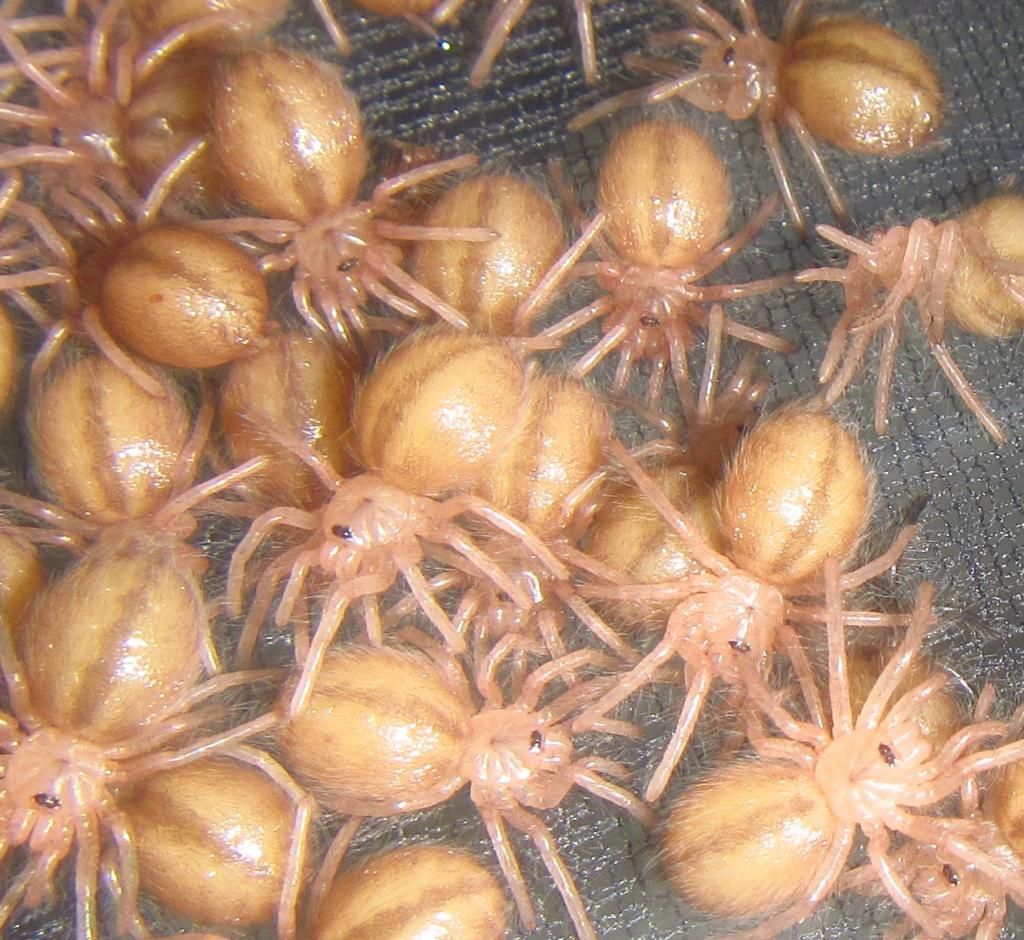
[SUP]First instars[/SUP]

[SUP]Deformed individuals. None of these survived[/SUP]
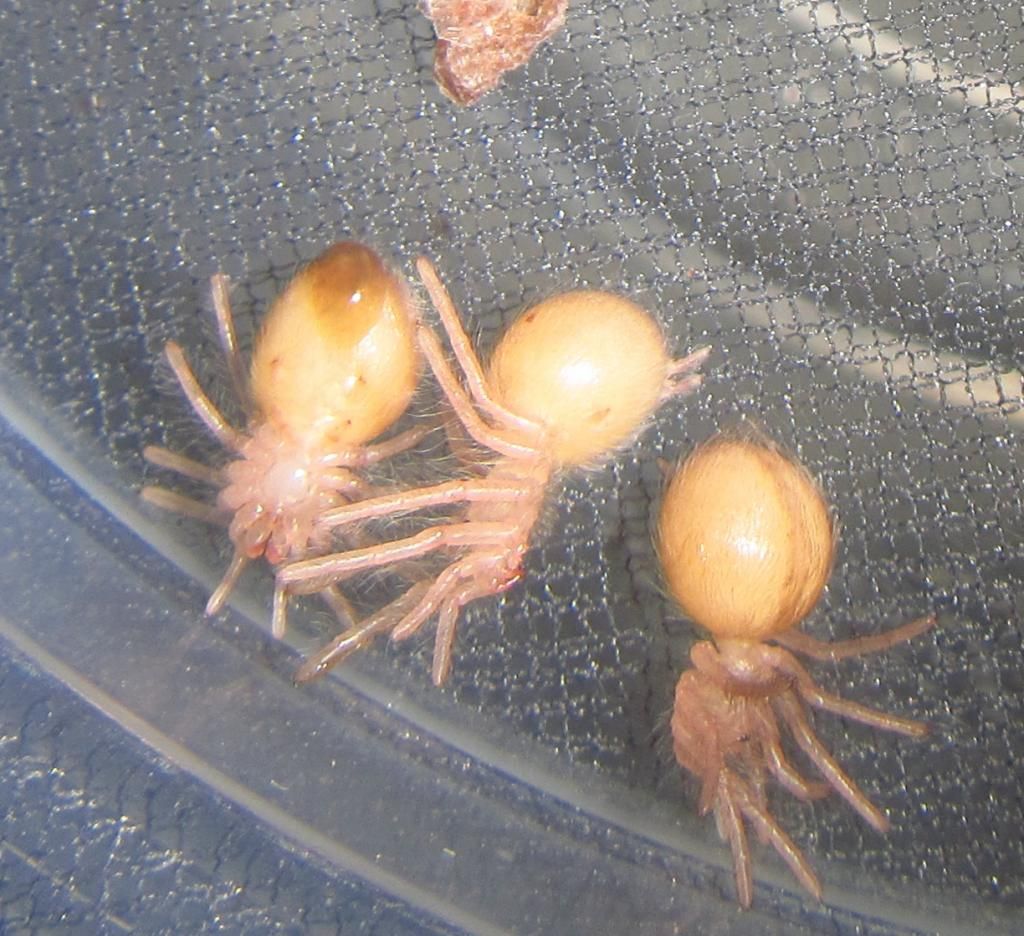
[SUP]Brown liquid from anus before dying[/SUP]
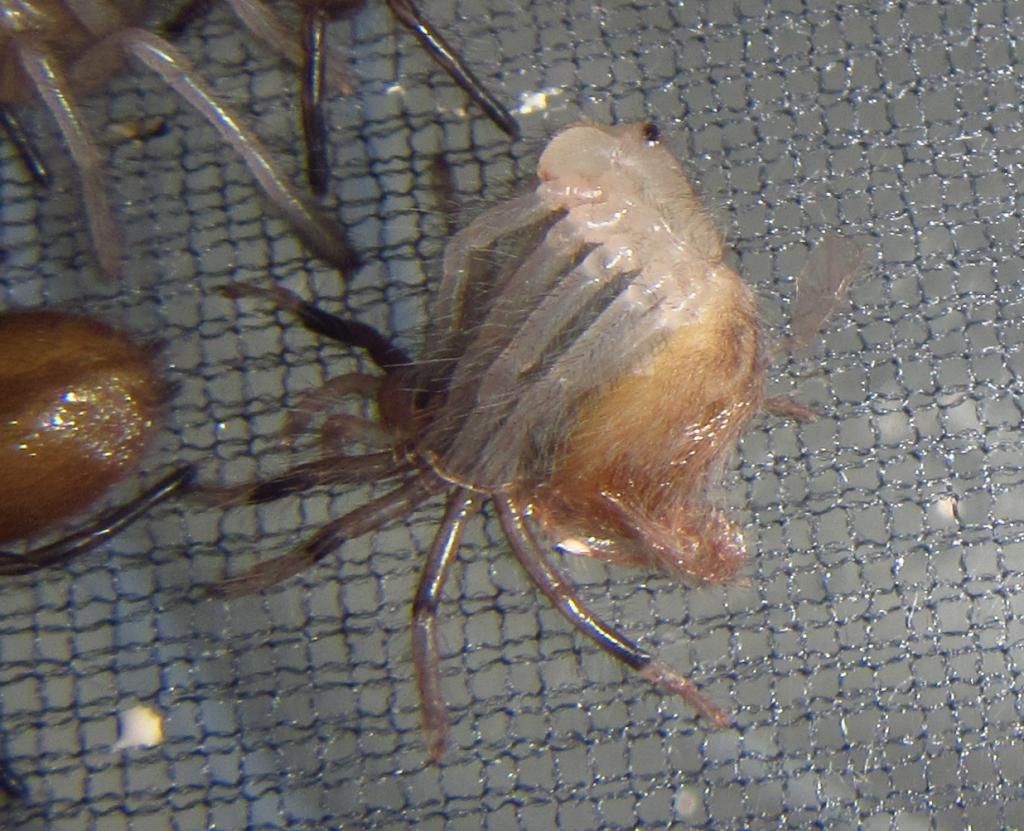
[SUP]Molting into second instar[/SUP]
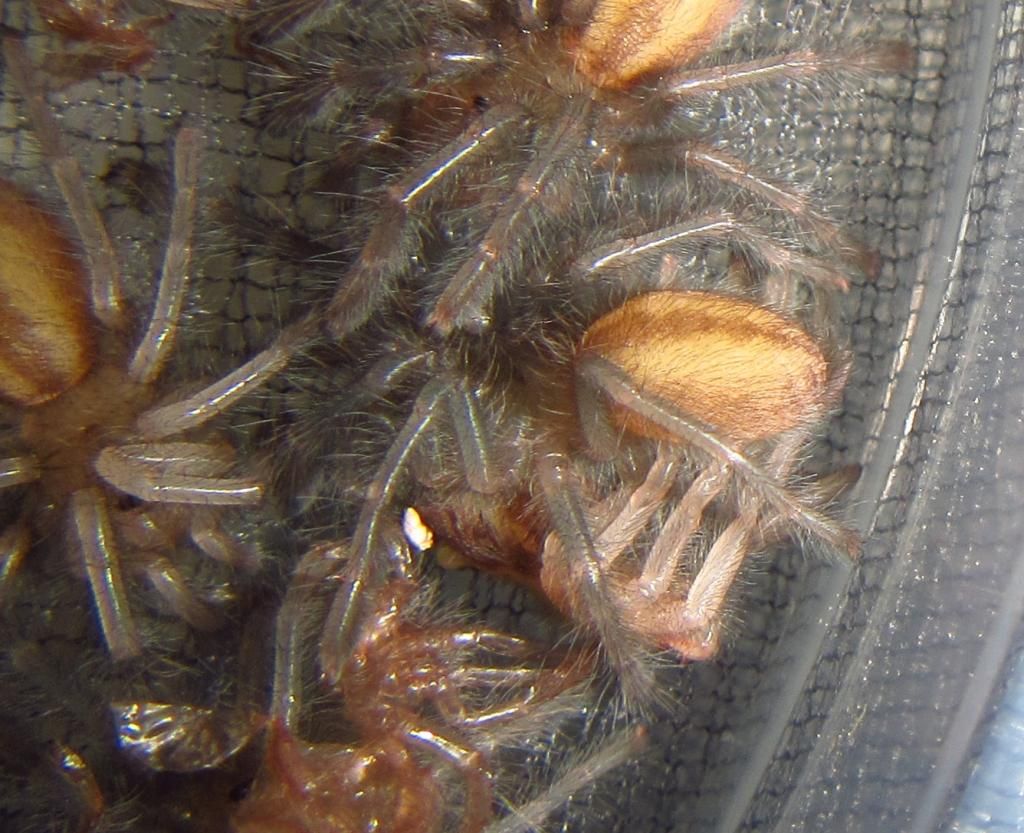
[SUP]Cannibalism of newly molted spiderling[/SUP]

[SUP]Resulting feeding frenzy[/SUP]
[YOUTUBE]UG-CxiT5glQ[/YOUTUBE]
[SUP]P. metallica in the middle of molting into second instar[/SUP]
Second instar to third instar
P. metallica do not actively hunt/feed at second instar like most species, and only begin to do so at third instar. It took another two weeks for them to molt into third instar, with the temps at about mid to high eightiess.
Since they were a lot more mobile and quick as second instar and were now able to stick onto the plastic, the flooded paper towels at the bottom of the incubator were replaced with moist coir. A few days after molting into second instar, all of the slings had climbed out from the horizontal pantyhose to live instead on the sides of the incubator. They rarely ventured onto the coir or on any horizontal surface for very long, and began to web up areas between the deli cup and incubator. As they began to darken and prepare to molt, this webbing became thicker and more extensive, with multiple tubes and web pockets. Some individuals were observed to create enclosed web spaces in which to molt, while a few decided to go back onto the suspended pantyhose, create a web mat, and molt there. A few were content to do neither, and simply molted where they hung, sometimes falling directly onto the coir.
Instances of molt chewing was again observed, though no instances of cannibalism were observed at all. The slings were promptly separated into individual enclosures, totaling fifty third instar slings.

[SUP]Second instars on the side of the delicup[/SUP]

[SUP]Second instar darkening up[/SUP]
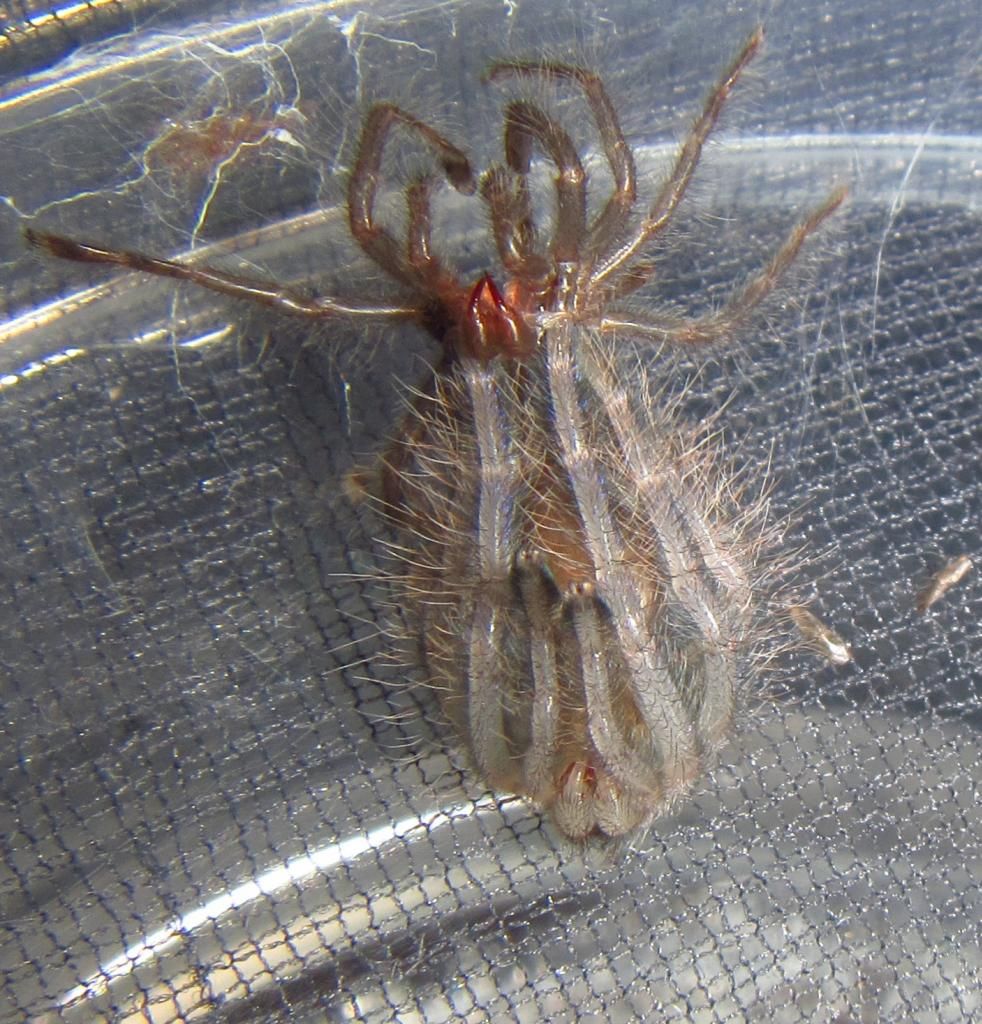
[SUP]Second instar molting into third instar[/SUP]
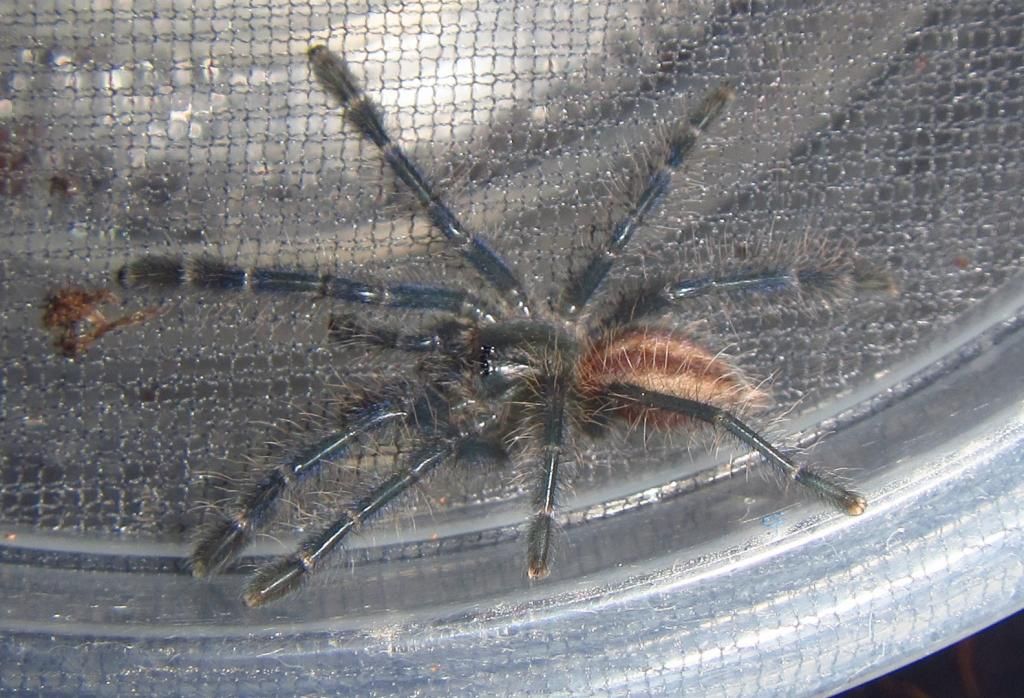
[SUP]Third instar P. metallica[/SUP]
Timeline
May 28 2013 - Male matured
August 3 2013 - Female molted
September 2 2013 - First pairing
September 29 2013 - Second pairing
May 13 2014 - Sac laid
June 3 2014 - Sac pulled
June 9 2014 - First post embryo hatches
July 1 2014 - First first instar molts out
July 13 2012 - First second instar molts out
July 27 2014 - First third instar molts out

[SUP]P. metallica third instar in enclosure[/SUP]
Preparation
Female is housed in a 12"x12"x18" enclosure, with a cork slab placed in the corner, creating a "tube" area for a hide. The bottom is slightly angled out to provide more room at the bottom.
The female has been (and will continue to be) subjected to seasonal changes that mirror native habitat (Hyderabad area) as close as possible. Using local weather as a guide, late Fall/Winter/early Spring was designated the rainy seasons (enclosure kept more humid, occasional mild "flooding" of substrate, cooler temperatures) while late Spring/Summer/early Fall became the dry seasons (drier enclosure/substrate, warmer temperatures). To achieve a "wet season", plastic was placed over the top vents of the enclosure, the water dish was kept full, and a rare slight flooding of the substrate was done. For the dry season, the plastic was removed, the substrate was allowed to become dry, and the dish was only filled occasionally. At no point during the breeding/incubation was temperature artificially changed, other than maintaining non-freezing, comfortable room temperature during winter time. The intent was simply to have distinct seasons; no special attention was paid to specific humidity or temperature values. Using this cycle, the female predictably molts in late July/early August, just past the middle of the dry season. Female was fed the night before mating attempts, though she did not eat the second time.
The male was acquired in late July; his maturing molt was 05/28/13. The male sustained serious injury to both back legs during transit, and was housed in a small 11"x5" round container with a piece of cork and water dish to recover (this became his enclosure for the duration of his stay with me).
Although he did recover enough to be able to function normally, he never fully regained a full range of motion in his back legs. He was allowed to create a sperm web before any pairings.
[YOUTUBE]EHliiqtbtso[/YOUTUBE]
[SUP]MM P. metallica injury[/SUP]
[youtube]_XPYtuOLMbs[/youtube]
[SUP]MM P. metallica tapping[/SUP]
Pairing
The male was simply placed into the females enclosure, at the foot of her hide. The male immediately began to rhythmically tap his palps, and the female could be heard responding with taps of her own.
The female emerged, and the male seemed adamant about luring her away from her hide, even trying to lure her outside of the enclosure. The females furrow visibly dilated during courtship. A few attempts were made by the male for an insertion that were not followed through for whatever reason, though both seemed eager to continue courtship (one attempt seen on the video below). After a few hours, a clear insertion was made by the male, that lasted less than a second. Immediately afterward, the female seemed to loose all interest in his company and very quickly retreated into her hide (by this time, they were on the opposite corner of the enclosure). The male did not pursue, but instead remained and continued to tap, but gradually stopped both in intensity and frequency. At this point, he was removed from the enclosure. A second successful pairing occurred about three weeks later that followed the same basic format at the first.
The male was never allowed to cohabitate with the female past an insertion. This female was paired only twice.
[YOUTUBE]HzQM3jq9gX0[/YOUTUBE]
[SUP]P. metallica pairing[/SUP]
Eggsac preparation and brooding
After the pairing, the female was continually kept as per the season, which at the time of pairing (early August) was just at the tail end of the dry season. She was gradually kept more humid beginning in mid October for the wet season until around April/May when things were dried out again. As things were getting warmer and drier, she barricaded herself in her hide with some excavated dirt from the bottom of her burrow. By mid May, as her enclosure remained almost bone dry, she made a sac in her excavated chamber at the bottom of her burrow.
At this point, in interest of keeping the sac from desiccating, her water dish was refilled and a small portion of her substrate moistened. The mother seemed to favor keeping the sac on the floor of chamber, and was rarely observed to be holding it up or anywhere off the floor. Disturbances were kept to a minimum, only the occasional check to see that she still, in fact, had the sac! She was not fed during the brooding period, as she remained inside her barricade for the entire duration.

[SUP]Mother with sac[/SUP]
Pulling the eggsac
The sac was pulled after three weeks. The female did not put up any kind of resistance, and made no attempt to recover the sac as it was pulled from under her.
When opened, it was discovered that the sac was still wet on the inside, though no rotten or ruptured eggs were to be seen.
Eggs were carefully rolled onto coffee filters to dry them out before placing them in the incubator. There were ninety three eggs in total, many of them obviously infertile.

[SUP]P. metallica sac[/SUP]

[SUP]P. metallica sac, opened[/SUP]
Incubation
Eggs/instars were incubated suspended on pantyhose over water using a delicup with the top cut off and pantyhose wrapped around the bottom. This was placed in a plastic container lined with sopping wet paper towels on the bottom. Four tiny ventilation holes were made on the top to keep humidity fairly high, and keep pests out.
Once they reached second instar, the delicup was placed in a container filled with moist coir, as the spiderlings had begun to crawl around.
Throughout incubation, the incubator was opened at least once every day to examine the slings and prevent stagnant air.

[SUP]Incubator, post first instar[/SUP]
Eggs to post embryos
Eggs showed development over the course of the week, with legs/carapace development being clearly observed inside the eggs.
Then, over the course of a few days, the eggs began hatching into post embryos about a week after the sac was pulled. Most of eggs successfully hatched on their own, but there were a few that failed to hatch despite obvious development underneath. These were manually hatched by very carefully applying gentle pressure between two wet fingers on the abdomen, in an attempt to "pop" the membrane without damaging the embryo underneath. Almost all of the eggs hatched this way had some kind of physical deformity, usually crooked legs.
At this point, all the unfertilized/dead eggs and were removed. Sixty three post embryos remained in total. The temperature during this part of the incubation hovered around the mid seventies.

[SUP]Newly hatched post embryos[/SUP]

[SUP]All the manually hatched post embryos[/SUP]
Post embryos to first instar
Post embryos began to molt into first instars after about three weeks. During that time temperatures again hovered around the mid seventies. As they progressed towards the molt date, they grew visibly darker, especially on the legs, and seemed to move their limbs about more. Most of the post embryos that were manually hatched either did not molt, or were unable to complete the molt despite obvious darkening. One individual became stuck halfway due to crooked legs, but was able to complete the molt after being moistened with water and the molt being held to allow gravity to assist. In addition to the above, a few individuals displayed leg deformities (short legs, legs curved the opposite way, clubbed legs, etc.). It is assumed these were the individuals manually hatched.

[SUP]Post embryos molting into first instar[/SUP]

[SUP]Problematic molt[/SUP]

[SUP]Assisted molt[/SUP]

[SUP]Deformed first instar[/SUP]
[YOUTUBE]xwab1VKrNrs[/YOUTUBE]
[SUP]First instars[/SUP]
First instar to second instar
First instars took a relatively short time to molt into second instars, at about two weeks. A possible explanation for this was the increased temperature; A local heat wave had temps up to the high eighties at some points during the two weeks.
During development, they gradually began to move more like spiders instead of slowly ambling around, and begun laying down very fine web. A few individuals had previously molted into, or eventually developed legs curving straight up. All of these individuals eventually died before molting into second instar, despite some of them darkening quite a bit in preparation of a molt. One individual began leaking brown liquid from the anus before finally stopping and dying. At this point, water drops and a very shallow water dish (2mm-3mm high) were added to the pantyhose in hopes of getting shots of them drinking, but they seemed to largely ignore them.
After molting, most of the second instars were observed to begin chewing on molts, as most other species often do to presumably conserve moisture. As more second instars began to emerge, some individuals began sucking on molts of others even as they were still on the way out. This led to some instances of cannibalism, where slings were preying on mid molt/freshly molted individuals. After a kill was made, may other surrounding second instars would latch on and feed together. No attempt was made to stop this, but the small water dish was filled up again and water drops added in case it was a hydration issue. The water was largely ignored. (note for anyone intending to breed these guys and are concerned about yield: separate at first instar!)

[SUP]First instars[/SUP]

[SUP]Deformed individuals. None of these survived[/SUP]

[SUP]Brown liquid from anus before dying[/SUP]

[SUP]Molting into second instar[/SUP]

[SUP]Cannibalism of newly molted spiderling[/SUP]

[SUP]Resulting feeding frenzy[/SUP]
[YOUTUBE]UG-CxiT5glQ[/YOUTUBE]
[SUP]P. metallica in the middle of molting into second instar[/SUP]
Second instar to third instar
P. metallica do not actively hunt/feed at second instar like most species, and only begin to do so at third instar. It took another two weeks for them to molt into third instar, with the temps at about mid to high eightiess.
Since they were a lot more mobile and quick as second instar and were now able to stick onto the plastic, the flooded paper towels at the bottom of the incubator were replaced with moist coir. A few days after molting into second instar, all of the slings had climbed out from the horizontal pantyhose to live instead on the sides of the incubator. They rarely ventured onto the coir or on any horizontal surface for very long, and began to web up areas between the deli cup and incubator. As they began to darken and prepare to molt, this webbing became thicker and more extensive, with multiple tubes and web pockets. Some individuals were observed to create enclosed web spaces in which to molt, while a few decided to go back onto the suspended pantyhose, create a web mat, and molt there. A few were content to do neither, and simply molted where they hung, sometimes falling directly onto the coir.
Instances of molt chewing was again observed, though no instances of cannibalism were observed at all. The slings were promptly separated into individual enclosures, totaling fifty third instar slings.

[SUP]Second instars on the side of the delicup[/SUP]

[SUP]Second instar darkening up[/SUP]

[SUP]Second instar molting into third instar[/SUP]

[SUP]Third instar P. metallica[/SUP]
Timeline
May 28 2013 - Male matured
August 3 2013 - Female molted
September 2 2013 - First pairing
September 29 2013 - Second pairing
May 13 2014 - Sac laid
June 3 2014 - Sac pulled
June 9 2014 - First post embryo hatches
July 1 2014 - First first instar molts out
July 13 2012 - First second instar molts out
July 27 2014 - First third instar molts out

[SUP]P. metallica third instar in enclosure[/SUP]
